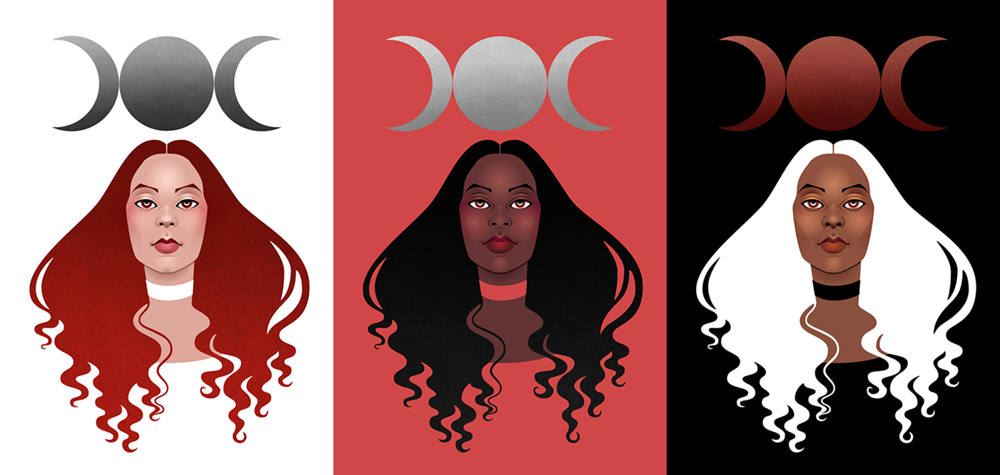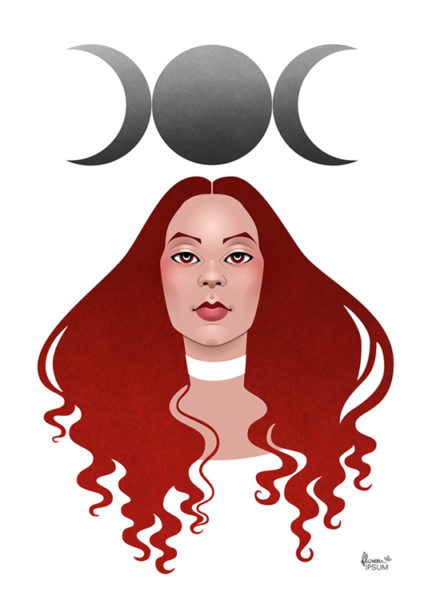
Isn’t it satisfying when things come in threes? I studied Celtic languages at uni, and the Celts sure loved organising their world into triads. And they were not alone.
Women — especially mythological women — often come in threes. Either as groups of three separate beings or as single deities with three distinct aspects or forms. In the Fertile Crescent there was Qetesh-Ishtar-Anat, the Greeks had triple-form Hecate, the Romans had Diana Triformis, the Celts had the Morrígan… Then there were of course the Parcae, the Moirai, the Nornir, the Matres, the Washerwomen, the Furies, the Graces… the three Marys in the Bible also fit this bill, as do the three witches in Macbeth… and that’s just in Europe!
Anyway, nowadays there’s this neopagan concept of the Triple Goddess — represented by the symbol of the waxing, full, and waning moon. The three moon phases correspond to the three stages of a woman’s life: the maiden, the mother, and the crone. They are sometimes also attributed the colours white, red, and black respectively.
I like the symbol and the link between the feminine and the moon — historically, many triple goddesses had something to do with the moon — and, as a former Celtic scholar, the three-ness pleases me greatly. But I don’t like the “maiden-mother-crone” distinction. Firstly, because those are very narrow categories that not every woman will fit. Secondly, because they see the woman from the outside. I want to see the woman from the inside (which, being one, is not terribly difficult). And what I see inside of a woman is multitudes of aspects, all at once! At every stage of life you might be just beginning thing A, reaching fulfillment in thing B, and withdrawing from thing C. And that’s beautiful and normal.

And that’s how I approached my Goddesses. Each of them is a separate character, inspired by the traditional maiden-mother-crone interpretation. But, while each is different, they resemble one another closely, and each contains aspects of the other two — which I illustrated with colour. Let’s have a look at the “Maiden”. Her face is fresh and white, but her hair is red and the moon above her head is black. It may be that her hair will grow darker with age — or maybe through her hair shines her raw power and sexuality, aspects typically associated with the “Mother”. Maybe the black moon is a new moon — or maybe it’s an old moon, a reflection upon an ending, typically expected from the “Crone”.
Perhaps one of the Goddesses will speak to you more than the other two — perhaps not. Can you see the three aspects in yourself? Or in the women around you? Let me know (:

Pingback: what happens if you miss a dose of amoxicillin
Pingback: neurontin for pain
Pingback: how long does flexeril stay in your system
Pingback: how long does augmentin take to work
Pingback: kaiser permanente contrave
Pingback: can you take aspirin while pregnant
Pingback: celecoxib brand name
Pingback: celebrex 200mg side effects
Pingback: is baclofen addictive
Pingback: abilify doses
Pingback: amitriptyline overdose treatment
Pingback: diltiazem 60 mg tablet
Your article helped me a lot, is there any more related content? Thanks!
Pingback: repaglinide impurity e
Pingback: how much tizanidine can i take
Pingback: actos diarrhea
Pingback: ivermectin 20 mg